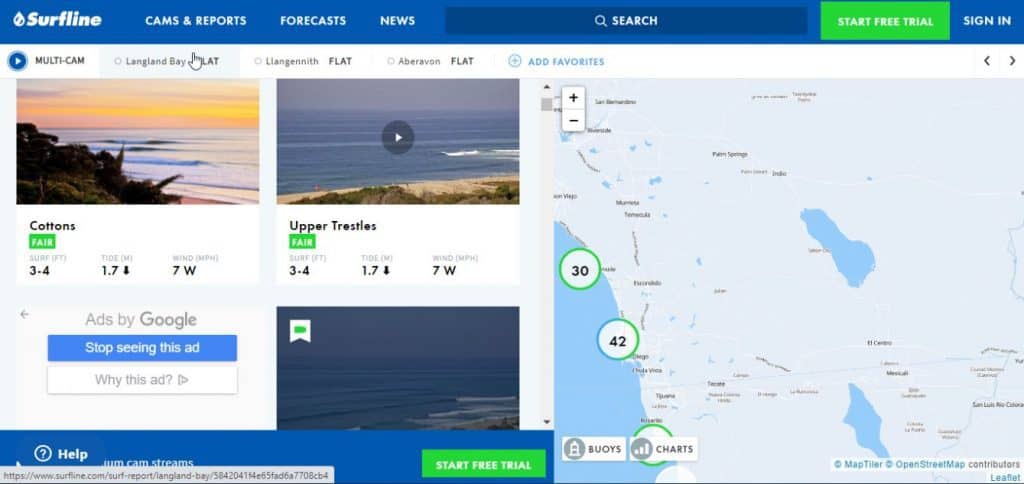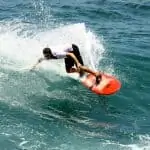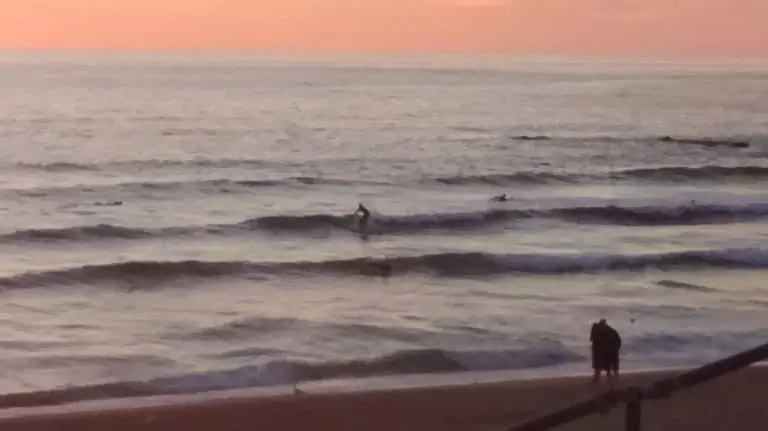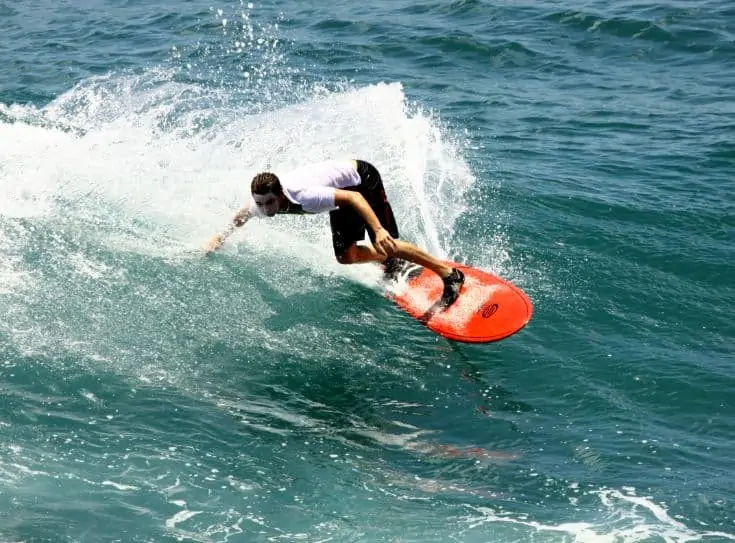Teach Yourself to Surf with THIS Guide!
Learning to surf is unlike just about any other sport as it has so many unique features and things to think about.
For this reason, surfing is hugely popular and more and more people are starting to surf each day, with everyone needing to learn from scratch.
A common question that many new surfers have is as follows:
Can I teach myself to surf? Yes, you can by following a clear plan, getting the right gear and sticking with it. It is not an overnight thing for anyone, so remembering that! That said, there are a few things you can do along the way to make it easier, as will be explained below.
So, now that you know that you can definitely learn to surf on your own, let’s have a look at the right way to do it to give you maximum confidence and get off to a flying start.
Get the Right Gear
Surfboard
One of the biggest things that novice surfers get wrong is trying to learn on too short of a board. This is something I did because I didn’t want to carry around a big board, but honestly, it must have set me back a few months.
Instead, get a board that is 2 feet longer than you are tall and has a soft-foam or ‘soft-top’ construction. This will be perfect for catching waves and also more forgiving when falling.
See this post for my recommended surfboard brands for beginner boards (PS I say ‘brands’ since they all have tons of models depending on your size/weight which are all well suited to learning to surf on!
You can also see this list I prepared of the best accessories to buy with your new surfboards, with no junk, just the good stuff.

Photo Credit: Steve Bates
Wetsuit and Other Essential Gear
Think about the water temperatures in your area and get the right wetsuit for your needs.
If you have a local surf store, make use of their knowledge and expertise by going in there and asking them for help (and of course, buying from them if the products are right for you!).
This is yet another reason why I recommend buying key items, like your first wetsuit, at a physical store wherever possible, as explained in my video on this topic below.
I’ve also prepared this article on buying a wetsuit for surfing if you need any more info on that topic!
Before You Hit the Water
Before even hitting the surf, there are quite a few things that you can do to help you learn, specifically the following:
- Focus on flexibility
- Go swimming
- Practise the pop-up movement
Flexibility is helpful because surfing involves so many dynamic movements and twists and turns. Getting to grips with things like yoga, pilates or just everyday stretching routines will help you massively when it comes time to actually surf.
Swimming is also a great workout and fitness booster that is closely related to surfing.
It will help being in the water and controlling your breathing, even though you won’t be in the sea, it will still do a lot of good.
Practising your pop-ups will also help massively when it comes time to hit the waves.
This is because the surfing pop-up, where you go from lying down to standing up, is probably the single-most difficult part of learning to surf! Without a pop-up, you cannot ride a wave, it is that simple.
Note that, you might experience some mild pain the first time you go surfing – see my post on rib pain for surfing to see what causes this and what you can do about it!
For more on the above and even suggestions for those of you who are landlocked, I’ve prepared a guide to learning to surf without water – check it out!
Friendly Advice
Now, the title of this post is about learning on your own, but really, you will always be asking for help from others, just as you would for anything in life.
With that in mind, try to seek out some friends and people in your area who have already learned to surf and ask them for any tips or tricks they might have. If you can’t find anyone, have a look online on social media sites and see if there are any other active learner surfers nearby who you could message or talk to.
Even better, find somone who you can go surfing with, ideally at a similar level or just ahead of you (intermediate and advanced surfers might take you to spots which are not beginner-friendly, I say that one from experience and an older brother!)
Having friends to go surfing with will keep you safe and make it that much more enjoyable. You’ll probably also learn quicker, too, as you can bounce ideas of each other and compare gear and share tips.
Learn from the Pros (Or Just Better Surfers)
A great way to learn is by watching others, be it in person or just on YouTube.
You can get a huge amount from just watching some great YouTube clips, especially ones where they show the take-offs as these can really help you to learn by watching.
A clip I saw a while back that I really enjoyed was this one of longboarding in Norway – watching small waves really helps learner surfers and I think you can get a lot from watching clips like this:
Another good clip is one of pro surfers popping up, where a YouTuber has put together an edit of how the best surfers in the world pop-up.
These were all taken from a pro surfing competition in 2018 and the narrator really drills down into the pop-up, which is really helpful. I know I got a lot from watching it and think you will, too!
Video Clips: Get Yourself on Film
To go along with the videos to watch above, perhaps the best thing you can do to learn to surf is actually get some video clips of you surfing.
You can capture your surfing on film by either getting a GoPro camera mounted onto your surfboard or by asking a friend to come along and film you from shore, even a smartphone would be fine for this.
Having clips of you learning to surf helps you to see exactly what you are doing from the front, so that you have a much better idea of what is going wrong when you try to pop-up, take off or ride a wave.
Lots of professional surfers even say that having video to watch of themselves in the early days was key to their surfing progress and development, and the same holds true for us average surfers, too.
I can say that seeing myself surfing on film for the first time was a bit of a shock but definitely helped me to iron out a few issues I had, particularly with the take off.
If you go down the GoPro route, which is a pretty good option, I’d recommend one of the earlier models of the GoPro Hero cameras from Amazon as they are compact, do everything you could need and are a lot cheaper than the latest top-end GoPro camera (like the GoPro Hero Session 4 I bought for my wife when she was learning a few years back, as you can see in the video below).
Pick Your Surf Spots Carefully
Just like having the wrong board, going to a surf spot that doesn’t suit your level will also set your surfing progress back.
This is because there’s a huge variety of surf spots around and they all have different features but the main points to look for in a good beginner surf spot are the following:
- Sandy bottom
- Other surf schools and learners around
- Lots of space
- Waves that aren’t bigger than chest high
All of these sound like common sense but some novice surfers get carried away and try to follow the crowd – BIG MISTAKE!
To learn to surf properly, you need a surf spot that is going to be forgiving (no rock/reef under you), will let you catch waves that are not too serious and where you’ll have space to do just that.
Waves that are too big will just be downright scary when you start, and increase the chances of you getting injured out in the surf, so even if you want to try bigger waves, give it some time and learn the fundamentals first.
Take a Note of the Best Surf Conditions
After finding the right spot for learning to surf, you’re going to want to figure out the right conditions for when is best.
Learning about surf conditions can take a long time, so it’s something you should work on, be it by keeping a log, journal or just notes on your phone.
The main things you want to find are some kind of webcam near where you will be surfing so that you can check it without going to the beach and a good surf website/app that works for you.
Surfline has some great free webcams and reports and is probably the best option for beginners, although you still need to read the reports regularly before they will make much sense since ‘2-3 feet’ in surf report terms might actually look like double that size in real terms in the water!

Personally, I like WindGuru but I know it’s a bit technical for beginners so won’t go into detail about it here but it’s nice because the website works well when you have low data on your smartphone, unlike some of the more ‘data-hungry’ websites out there.
Magicseaweed is another good surf forecasting website that is more learner-friendly.
Going back to talking about surf conditions in general, wind is another big factor.
Note that the best winds for surfing are generally early morning or late afternoon so bear that in mind and also check the surf report’s wind forecast for light colors (dark colors usually mean strong wind = no bueno!)
Finally, we come onto tide, which can be quite the mystery since it changes a lot for surf spots. In short, avoid the extremes of dead or dead low and try to surf on an incoming tide where possible. For a more detailed run-down, see my dedicated guide to choosing the best time/tide for learning to surf!
Hit a Nearby Wave Pool (Soon?)
It’s crazy to say but surfing wave pools are now going mainstream and are suddenly popping up everywhere, which is great news for surfers.
The brilliant thing about wave pools for learner surfers is that they are consistent, safe and offer guaranteed waves, meaning you can pay, go at the right time and be 100% sure you will be getting waves suited to your ability, something that you can’t do in the ocean!
Now I know, not everyone will have this option near where they live, but if you have a look on google, you may find some wave pools that are planned in your area.
Below is a video of some learner surfers having a blast in a wave pool in Waco, Texas, an inland city about 90 minutes’ drive from Dallas!
The only downside to wave pools is the cost, but this can also be offset by the convenience and the fact that you may spend a lot of time and money driving around looking for waves anyway, so why not spend some of that on a wave pool session instead?
Be Patient and Have Fun
Perhaps the most important part of learning to surf is to actually enjoy every minute of it!
It’s a wild ride and takes a long time but you will get there with patience and persistence.
Just remember the above and don’t give up as it can feel like you are getting nowhere then, all of a sudden, you have the ride of your life!
Can I surf without lessons?
Yes, you can but I would recommend actually get one surf lesson to start since this can give your surfing start a massive boost.
Once you hav had a lesson, you can then go on with the knowledge gained and really make quick work of any obstacles that might come your way.
Now, that is not to say that a surf lesson is a replacement for experience, but it will certainly fast-track your surfing progress if you have a lesson right at the start.
From there, it’s still lots of trial and error but at least you will have an idea of some of the key things to think about.
How long does it take to get good at surfing?
Being able to competently ride an unbroken wave in a confident and controlled manner will usually takes dozens of hours of practice in the surf, and even then that is if you are surfing the right spots with the right gear, as well as having a good level of physical fitness.
Doing anything less can really set you back, so focus on embracing the learner surfer approach and take it easy, and of couse, have lots of fun!
I have more time estimates on how long it takes to learn to surf if you are curious and want to get a clearer picture.

The video below also has some good tips to help you along on your solo learn to surf journey!

Related Questions
Can you wear a life jacket while surfing? Not for standard surfing since a life jacket will interfere with your ability to lie flat on your surfboard and paddle properly. It will also make it difficult to breathe. That said, big-wave tow-surfers do wear life jackets, and there are other options.
Tow-surfers can wear life jackets because they are pulled into waves from behind a jet ski and are standing up all the time, making it possible to wear a life jacket.
However, a fairly new innovation is that of the surfing inflation vest, which inflates when pulled bringing a surfer back up to the surface very quickly. That said, these are only to be used by experienced surfers and most stores will require some kind of waiver before selling them.
As you can see from the video below, these are used by professional surfers on the Big Wave World Tour, so they are both serious and important pieces of kit.
When should you stand up when surfing? When you are paddling for a wave and you feel the wave start to push your forward is the time to stand up. You need to time it so that you don’t get up too early, and fall off the back of the wave, and not too late, falling headfirst down the wave.
It’s something that gets easier with practice but there is no true way to say, it’s a feeling and the experience that you get from trying (and failing) is the only way to get better at this.
Just remember to notice the feeling each time and start to pick up on the signals of movement and go with the feeling. It will and does get easier from there!



